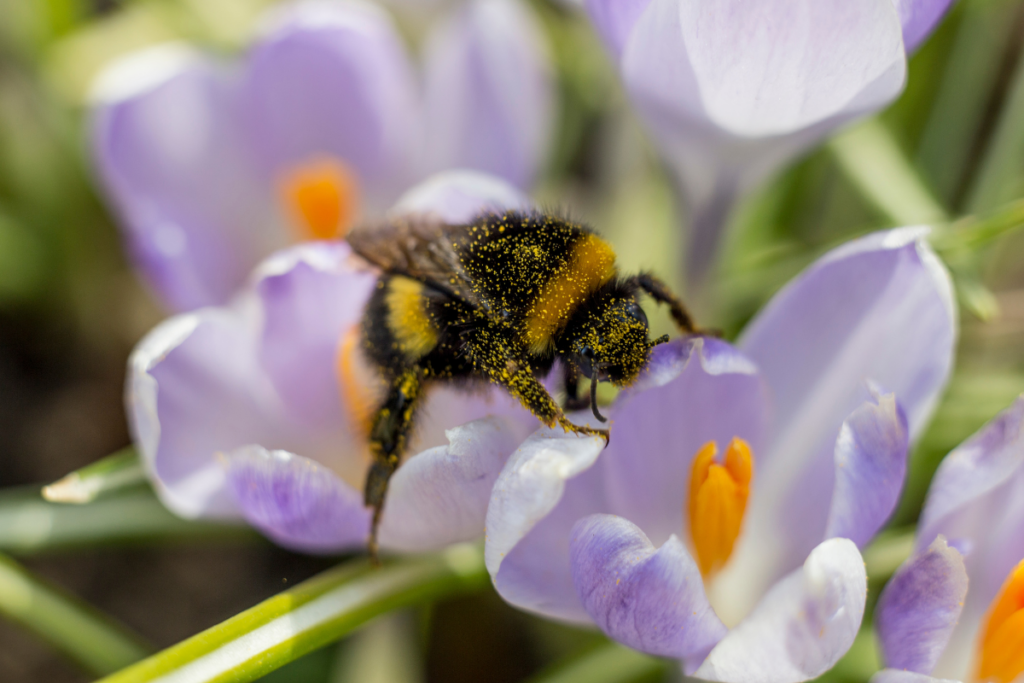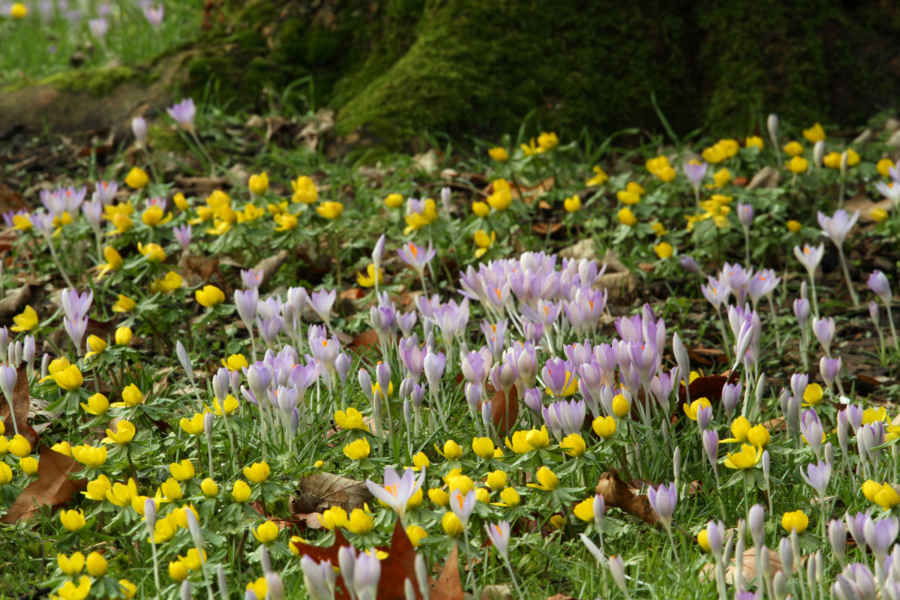Val explains the important role these delightful pollinators play and how to encourage and protect them.
In the last couple of weeks, I’ve put those winter jobs, such as leaf picking and pruning, behind me. Now I’m admiring the first flowers of the year. Snowdrops are everywhere, of course, and many of mine are tucked under my roses. Cyclamen coum is in full flow all along my front path, in one of the sunniest positions in the garden. The rounded foliage and jaunty flowers welcome me home, along with the scent of Sarcococca confusa.
Crocus tommasinianus is taking over my main bulb lawn, along with patches of winter aconites also called Eranthis hyemalis. The combination of yellow and purple is heart-warming on a chilly February day. Both of these bulbous plants spread by setting seeds, but they only do so if they can attract a pollinator. The earliest flying bees in our gardens are in search of nectar, the sugar-rich energy drink. It’s the bee equivalent of Lucozade. After they’ve topped up their energy levels, they go on to collect protein-rich pollen and this enables them to raise their offspring.
Nectar flow is encouraged by warmth
This is why early flowers need placing in a sheltered spot. As bees and bumblebees seek out sweetness, their furry bodies get an accidental dusting of pollen. That pollen is taken to other flowers, a process called outcrossing, and it’s a necessary part of seed setting for most plants. Winter aconites are clever little things. They only open their rounded flowers once temperatures approach 10C, because they know they’re more likely to get a visiting bee when it’s warm. In other words, winter aconites need winter sun in order to open their flowers. However, they resent being baked by summer sun. This is why they thrive underneath deciduous trees. These provide summer shade.
I’ve already seen my first bumblebee, a large the Buff-tailed bumblebee queen. The Latin name, Bombus terrestris, refers to terra for ground because this bee nests in old mouse holes or hollows. She’s the largest and earliest bumblebee queen and she has an orange-yellow band on her thorax, or body, and a beige-buff tail. She’s a short-tongued bumblebee so you’ll see her on crocuses, hellebores and winter aconite, drinking the nectar and spreading the pollen about. She can’t get her short tongue down tubular flowers, so she bites into the back of the tube and robs the nectar out.

Climate change is affecting our bees
Twenty years ago, I used to see buff-tailed bumblebee queens on clement January afternoons, but it’s usually February these days. I think it’s because they are staying active later into the year due to climate change. We need to look after bumblebees because they’re probably the gardener’s best pollinator, for three reasons. They are able to fly on cooler days, when honey bees stay warm in their well-stocked hives. They browse from flower to flower, unlike honey bees who’s only visit the flowers flagged up by the waggle dancers. They are the only bees able to buzz pollinate. That means they shake stubborn pollen down by vibrating.
One of my best bumblebee plants is the winter-flowering clematis
On my south-facing wall – Clematis cirrhosa var. balearica. This evergreen, no-prune clematis has pendent cream bells lightly spotted in maroon. It’s Majorcan, so it needs a warm wall. Given that, it flowers from late-January through to March. The ferny, dark foliage is almost as attractive as the flowers. It has one bad habit. It sometimes sheds all its leaves following a hot summer. It’s not dead though, just resting up.
We need our bees in order to survive
They pollinate 70 of the 100 or so crop species that feed 90% of the world. We would starve without them. They are declining for complex reasons. It’s part climate change and loss of habitat, but it’s also pesticide use in farming and horticulture.
Pesticides are harmful to bees and that’s especially true of neonicotinoids. Many were banned in the UK in 2018. Sugar beet is prone to flea beetle so the UK government’s Farming Minister, Mark Spencer, has just approved ‘emergency’ authorisation for the use of a highly damaging neonicotinoid called Thiamethoxam on sugar beet crops. This is the fourth year in a row.
I may get letters, but last year 30% of sugar beet farmers chose not to use neonicotinoids. Thiamethoxam is lethal – even a miniscule trace of this toxin can disrupt a bee’s ability to navigate and reproduce, significantly reducing the chance of survival. Research published in 2023 found harmful neonicotinoids were present in more than 10% of English rivers. Three thousand and eighty invertebrates may be being exposed to this toxin.
Rivers and reservoirs accumulate toxins
DDT, for instance was banned in the UK in 1986 because it was dangerous to wildlife and the environment. It may surprise you to know that DDT residues are still present in the mud at the bottom of the River Severn, nearly forty years later. Metaldehyde, the active ingredient in blue slug pellets, was banned because it was leaching into rivers and reservoirs. Following the wet summer of 2012, levels of metaldehyde reached almost 25 times the Drinking Water Standard (around 2.5µg/l) in some parts of the UK. To quote Thames Water: “metaldehyde can’t be easily removed, even with advanced water treatment processes”.
Gardeners can do their bit by not using pesticides. This will allow you to develop a healthy self-sustaining eco system. You’ll get more bees and you’ll be healthier too.
Find more tips, advice and articles like this at the Amateur Gardening website. Subscribe to Amateur Gardening magazine now.





